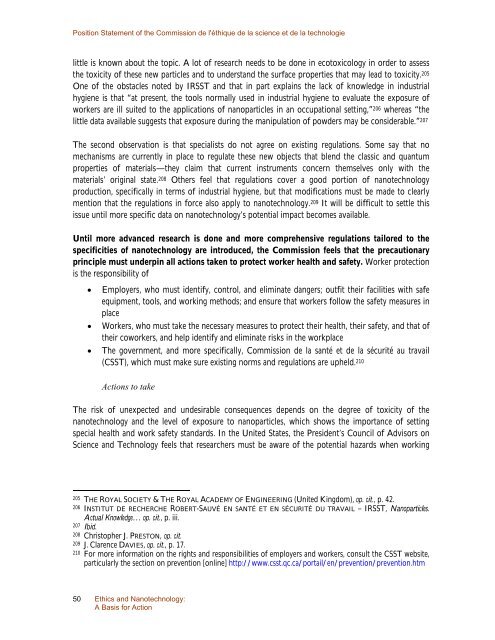A Basis for Action - Commission de l'éthique de la science et de la ...
A Basis for Action - Commission de l'éthique de la science et de la ...
A Basis for Action - Commission de l'éthique de la science et de la ...
You also want an ePaper? Increase the reach of your titles
YUMPU automatically turns print PDFs into web optimized ePapers that Google loves.
Position Statement of the <strong>Commission</strong> <strong>de</strong> l'éthique <strong>de</strong> <strong>la</strong> <strong>science</strong> <strong>et</strong> <strong>de</strong> <strong>la</strong> technologie<br />
little is known about the topic. A lot of research needs to be done in ecotoxicology in or<strong>de</strong>r to assess<br />
the toxicity of these new particles and to un<strong>de</strong>rstand the surface properties that may lead to toxicity. 205<br />
One of the obstacles noted by IRSST and that in part exp<strong>la</strong>ins the <strong>la</strong>ck of knowledge in industrial<br />
hygiene is that “at present, the tools normally used in industrial hygiene to evaluate the exposure of<br />
workers are ill suited to the applications of nanoparticles in an occupational s<strong>et</strong>ting,” 206 whereas “the<br />
little data avai<strong>la</strong>ble suggests that exposure during the manipu<strong>la</strong>tion of pow<strong>de</strong>rs may be consi<strong>de</strong>rable.” 207<br />
The second observation is that specialists do not agree on existing regu<strong>la</strong>tions. Some say that no<br />
mechanisms are currently in p<strong>la</strong>ce to regu<strong>la</strong>te these new objects that blend the c<strong>la</strong>ssic and quantum<br />
properties of materials—they c<strong>la</strong>im that current instruments concern themselves only with the<br />
materials’ original state. 208 Others feel that regu<strong>la</strong>tions cover a good portion of nanotechnology<br />
production, specifically in terms of industrial hygiene, but that modifications must be ma<strong>de</strong> to clearly<br />
mention that the regu<strong>la</strong>tions in <strong>for</strong>ce also apply to nanotechnology. 209 It will be difficult to s<strong>et</strong>tle this<br />
issue until more specific data on nanotechnology’s potential impact becomes avai<strong>la</strong>ble.<br />
Until more advanced research is done and more comprehensive regu<strong>la</strong>tions tailored to the<br />
specificities of nanotechnology are introduced, the <strong>Commission</strong> feels that the precautionary<br />
principle must un<strong>de</strong>rpin all actions taken to protect worker health and saf<strong>et</strong>y. Worker protection<br />
is the responsibility of<br />
• Employers, who must i<strong>de</strong>ntify, control, and eliminate dangers; outfit their facilities with safe<br />
equipment, tools, and working m<strong>et</strong>hods; and ensure that workers follow the saf<strong>et</strong>y measures in<br />
p<strong>la</strong>ce<br />
• Workers, who must take the necessary measures to protect their health, their saf<strong>et</strong>y, and that of<br />
their coworkers, and help i<strong>de</strong>ntify and eliminate risks in the workp<strong>la</strong>ce<br />
• The government, and more specifically, <strong>Commission</strong> <strong>de</strong> <strong>la</strong> santé <strong>et</strong> <strong>de</strong> <strong>la</strong> sécurité au travail<br />
(CSST), which must make sure existing norms and regu<strong>la</strong>tions are upheld. 210<br />
<strong>Action</strong>s to take<br />
The risk of unexpected and un<strong>de</strong>sirable consequences <strong>de</strong>pends on the <strong>de</strong>gree of toxicity of the<br />
nanotechnology and the level of exposure to nanoparticles, which shows the importance of s<strong>et</strong>ting<br />
special health and work saf<strong>et</strong>y standards. In the United States, the Presi<strong>de</strong>nt’s Council of Advisors on<br />
Science and Technology feels that researchers must be aware of the potential hazards when working<br />
205 THE ROYAL SOCIETY & THE ROYAL ACADEMY OF ENGINEERING (United Kingdom), op. cit., p. 42.<br />
206 INSTITUT DE RECHERCHE ROBERT-SAUVÉ EN SANTÉ ET EN SÉCURITÉ DU TRAVAIL – IRSST, Nanoparticles.<br />
Actual Knowledge… op. cit., p. iii.<br />
207 Ibid.<br />
208 Christopher J. PRESTON, op. cit.<br />
209 J. C<strong>la</strong>rence DAVIES, op. cit., p. 17.<br />
210 For more in<strong>for</strong>mation on the rights and responsibilities of employers and workers, consult the CSST website,<br />
particu<strong>la</strong>rly the section on prevention [online] http://www.csst.qc.ca/portail/en/prevention/prevention.htm<br />
50 Ethics and Nanotechnology:<br />
A <strong>Basis</strong> <strong>for</strong> <strong>Action</strong>
















